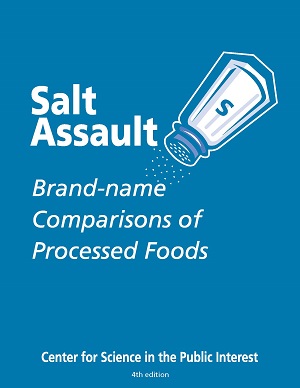Sodium declines in packaged and restaurant foods but further reductions needed

Uneven results point to need for FDA guidance, says CSPI
In 2005, the nonprofit Center for Science in the Public Interest began monitoring the sodium content of more than 500 supermarket and restaurant foods. Of the 451 foods still on the market, sodium decreased in 248 foods, or 55 percent, and increased in 135, or 30 percent of foods. Sixty-eight products, or 15 percent of those monitored, remained the same.
On average, the products monitored had an average decrease of 41 milligrams of sodium per 100 grams of the product. In 2005 CSPI petitioned the Food and Drug Administration and U.S. Department of Agriculture to set mandatory ceilings on sodium in different categories of packaged foods—a proposal backed by a 2010 Institute of Medicine report.

After the 2010 IOM report the FDA began working to develop voluntary sodium-reduction targets for industry to meet, but those targets have yet to be issued.
“For 40 years, the food industry has offered voluntary action to reduce sodium in packaged foods, and for 40 years, the FDA has obediently observed from the sidelines,” said CSPI president Michael F. Jacobson. “This has resulted in an uneven playing field for industry with some companies stepping up and others doing little. Excess sodium in our foods is prematurely disabling or killing tens of thousands of Americans each year.”
CSPI’s survey, Salt Assault, found dramatic variations in sodium content among different brands of a given food. Arnold Stone Ground 100% Whole Wheat bread had 49 percent more sodium than Pepperidge Farm’s Farmhouse Soft Whole Wheat bread (520 milligrams versus 150 mg per 100 grams), and Hunts Diced Tomatoes had 60 percent more sodium than Del Monte Diced Tomatoes (165 mg versus 103 mg per 100 g). Arby’s Curly French Fries has more than four times as much sodium as McDonald’s French Fries (735 mg versus 171 mg per 100 g). Those kinds of variations suggest that the brands at the higher end of the sodium spectrum have a lot of room for reduction, says CSPI.
Some companies have made concerted commitments to reduce sodium in their product lines, according to CSPI, citing efforts by General Mills, Nestlé, Mars, McDonald’s, and Walmart. Still, however, some companies increased the sodium content of products in CSPI’s market basket. Perdue’s Boneless Skinless Chicken Breasts with Rib Meat increased by 262 percent since 2005. The sodium content in Amy’s Organic Lowfat Cream of Tomato Soup nearly doubled between 2005 and 2015. And plenty of high-sodium products remained high in sodium: a package of Hungry Man Boneless Chicken Dinner has 1,830 mg of sodium.
The 2015–2020 Dietary Guidelines for Americans recommends a daily limit of less than 2,300 mg of sodium per day. But people with hypertension and pre-hypertension—about two-thirds of the adult population—are advised to limit sodium to 1,500 mg per day.On average, the products monitored had an average decrease of 41 milligrams of sodium per 100 grams of the product. In 2005 CSPI petitioned the Food and Drug Administration and U.S. Department of Agriculture to set mandatory ceilings on sodium in different categories of packaged foods—a proposal backed by a 2010 Institute of Medicine report.
After the 2010 IOM report the FDA began working to develop voluntary sodium-reduction targets for industry to meet, but those targets have yet to be issued.
“For 40 years, the food industry has offered voluntary action to reduce sodium in packaged foods, and for 40 years, the FDA has obediently observed from the sidelines,” said CSPI president Michael F. Jacobson. “This has resulted in an uneven playing field for industry with some companies stepping up and others doing little. Excess sodium in our foods is prematurely disabling or killing tens of thousands of Americans each year.”
CSPI’s survey, Salt Assault, found dramatic variations in sodium content among different brands of a given food. Arnold Stone Ground 100% Whole Wheat bread had 49 percent more sodium than Pepperidge Farm’s Farmhouse Soft Whole Wheat bread (520 milligrams versus 150 mg per 100 grams), and Hunts Diced Tomatoes had 60 percent more sodium than Del Monte Diced Tomatoes (165 mg versus 103 mg per 100 g). Arby’s Curly French Fries has more than four times as much sodium as McDonald’s French Fries (735 mg versus 171 mg per 100 g). Those kinds of variations suggest that the brands at the higher end of the sodium spectrum have a lot of room for reduction, says CSPI.
Some companies have made concerted commitments to reduce sodium in their product lines, according to CSPI, citing efforts by General Mills, Nestlé, Mars, McDonald’s, and Walmart. Still, however, some companies increased the sodium content of products in CSPI’s market basket. The sodium content in Amy’s Organic Lowfat Cream of Tomato Soup nearly doubled between 2005 and 2015. And plenty of high-sodium products remained high in sodium: a package of Hungry Man Boneless Chicken Dinner has 1,830 mg of sodium.
The 2015–2020 Dietary Guidelines for Americans recommends a daily limit of less than 2,300 mg of sodium per day. But people with hypertension and pre-hypertension—about two-thirds of the adult population—are advised to limit sodium to 1,500 mg per day.

